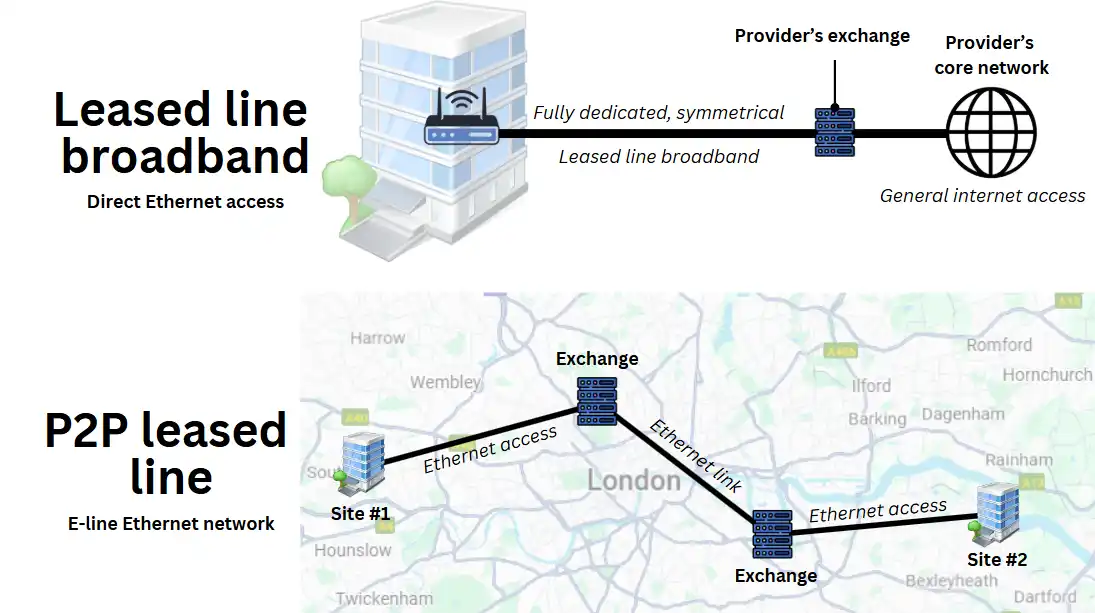Point-to-point leased line
Request point-to-point leased line quotes today
Just enter your business postcode…
Request point-to-point leased line quotes today
Just enter your business postcode…
Get the best deals from our experts
A point-to-point leased line connects two business sites directly, giving you a private, high-speed data connection that doesn’t share bandwidth with anyone else. It’s ideal for linking offices, data centres or remote buildings that need to transfer large files or access shared systems securely.
Our business broadband experts manage the entire process from quote to installation, ensuring everything runs smoothly.
Here’s how it works:

Start by entering your postcode and a few details about your business locations. This helps us identify the most suitable point-to-point leased line options available in your area.

A networking specialist will contact you to explain your options, answer questions, and recommend the most efficient connection type for your setup.

We’ll coordinate the installation with your chosen provider to ensure both ends of your network are connected quickly and professionally, with minimal disruption to your business.
A point-to-point (P2P) leased line connects two business sites with a dedicated internet connection designed specifically for routing data between those locations.

Also known as P2P Ethernet, this private link operates independently of either site’s general internet connection and is commonly used to interconnect offices, data centres, warehouses, labs, hospitals, and universities.
By contrast, leased line business broadband (also known as Ethernet Access or Direct Internet Access) only delivers general internet access to a single site. It is a premium internet service (dedicated bandwidth, symmetrical speeds, and robust SLAs), but it does not form a private site-to-site link.
In summary:
Both can work simultaneously by plugging into different ports of a multi-WAN business broadband router.
Because both services are Ethernet-based, a standard leased line can be upgraded into a P2P access point (and vice versa) with minimal disruption.
The table below summarises the key differences:
| Feature | P2P Leased Line | Leased Line Broadband |
|---|---|---|
| Connectivity | Private, uncontended site-to-site communication | Internet connectivity for a single site |
| Internet access | No (unless routed through another site or a separate broadband connection) | Yes (direct internet access) |
| Use cases | Office interlinking, data centre sync, internal systems | Everyday business connectivity, cloud apps, cloud VoIP, email, etc |
| Bandwidth | Dedicated, symmetrical | Dedicated, symmetrical |
| Service Level Agreements | Yes | Yes |
| Ethernet compatibility | Yes | Yes |
A point-to-point (P2P) leased line relies on Ethernet technology to form a dedicated, high-speed link between two business sites.
Here is a step-by-step of how data is transferred across this connection:


At the premises at either end of the point-to-point connection, data leaves your local area network through an Ethernet connection into the router or modem and travels via a dedicated fibre line to the provider’s nearest PoP (Point of Presence).
At the PoP, a network switch based at the local exchange connects your site to the provider’s core network for consistent performance and reliability.

Your data then moves through the provider’s low-latency backbone, a professionally managed high-speed route that carries traffic for thousands of businesses.
A secure virtual tunnel is formed between exchanges to keep your data separate from all other users.
Providers can also partner with other carriers to extend connectivity nationally or internationally.

The P2P leased line service is the integration of the site-to-exchange and exchange-to-exchange segments into a single, unified connection, also known as a business ethernet network.
Your provider can manage bandwidth, add new sites or adjust capacity as your business grows, all within a private, secure network.

P2P leased lines can integrate with SD-WAN solutions, site-to-site VPNs, or even MPLS, to enhance routing and security.
Installing a point-to-point (P2P) leased line usually takes between two weeks and several months, depending on the complexity of the Ethernet access at each site.
As with other leased line installations, the process involves building dedicated fibre optic connections, configuring the link between locations, and ensuring it meets the agreed Service Level Agreement (SLA) standards.

Typical duration: 1–3 months
Each site needs to be connected to the nearest network exchange using dedicated fibre optic lines. Urban areas can often use existing ducts, while rural or complex sites normally require new infrastructure. Where fibre isn’t feasible, Ethernet-in-the-First-Mile can be used as a copper alternative.

Typical duration: 1–2 weeks
Once both broadband connections are live, your provider sets up the dedicated virtual link between sites, merging each segment into one logical connection. This ensures the connection remains uncontended, symmetrical, and resilient. Optional redundant connections can be added for failover and business continuity.

Typical duration: 1–2 weeks
If your business uses other networking technologies, this link needs to be integrated with them. This stage is usually managed by your IT team or your managed service provider, and is straightforward if planned. The process is complete once the connection operates seamlessly across all sites.
Point-to-point (P2P) leased lines deliver highly reliable, efficient site-to-site communication.
Here are the key features that make them ideal for business connectivity:

Each connection provides dedicated, fixed-capacity bandwidth unaffected by network congestion, meaning no bandwidth throttling even during peak times.
Upload and download speeds are identical, ensuring consistent performance for real-time applications and large file transfers.

P2P leased lines are consistently lower latency than traditional broadband, ideal for real-time services such as phone systems for remote teams, video conferencing, and cloud applications.

Built on standard Ethernet technology, P2P leased lines can connect sites across towns, regions, or even internationally.
As long as both sites fall within your provider’s network coverage, distance does not limit performance.

Strong SLAs typically guarantee 99.9% uptime, sub-5ms latency on domestic links, and minimal packet loss.
Optional features such as business broadband failover and network load balancing can further enhance service reliability.

Built on Ethernet protocols, P2P leased lines are easy to scale.
Your provider can increase or decrease bandwidth remotely with no on-site work, and new links can be added as your network grows.

P2P leased lines form the foundation for advanced networking technologies such as MPLS, SD-WAN, and VPNs, improving routing, performance, and cybersecurity.

Most P2P leased lines come with 24/7 business-grade support and guaranteed response times.
When delivered through a Managed Service Provider, you also benefit from proactive monitoring and diagnostics to minimise downtime.

Each point-to-point connection is private as data runs on dedicated lines in the last mile, reducing the risk of unauthorised access or interception compared with shared internet services.
For complete protection, businesses often add VPN-over-Ethernet or SD-WAN security alongside firewalls to ensure full end-to-end security.
Point-to-point leased line costs vary based on distance, bandwidth, installation work, and service level.
It’s more expensive than leased line business broadband because the provider needs to maintain a dedicated channel across its core network for you.
Here is an estimate of the costs:
| Cost area | Details | Typical price range |
|---|---|---|
| Installation | Based on site location and infrastructure. Includes leased line installation, circuit provisioning, and configuration of the P2P link. | £500 to £2,000 (often waived on 36-month contracts) |
| 10 Mbps monthly rental | Suitable for light data use (e.g. voice-only business VoIP phone system) or backup connections between sites. | £200 to £350 per month |
| 100 Mbps monthly rental | Common choice for medium-sized businesses requiring consistent site-to-site performance. | £400 to £800 per month |
| 1 Gbps monthly rental | Designed for high-capacity or data-intensive operations. | £1,000 to £2,500 per month |
| Bundled services | Providers may include network monitoring, configuration, and 24/7 support with managed packages. | Varies |
A number of UK leased line providers offer point-to-point (P2P) connectivity for businesses needing secure, high-speed links between multiple sites.
These business broadband providers handle installation, configuration, and ongoing management to ensure reliable, symmetrical performance.
Enter your postcode above and our broadband experts will help you find the most suitable P2P leased line provider for your business.

BT business broadband delivers P2P leased line services across its national fibre network. Each connection offers guaranteed bandwidth, strong SLAs, and the option to integrate with wider enterprise networks.

Vodafone business broadband provides managed P2P leased line connectivity between business sites nationwide. Its fibre infrastructure supports integration with MPLS, SD-WAN, and other enterprise-grade systems.

TalkTalk business broadband offers cost-effective P2P leased line services with symmetrical speeds and dependable uptime. Its national reach makes it suitable for multi-site organisations across the UK.

Virgin Media business broadband supplies high-capacity P2P leased line services using its extensive fibre network. These connections are ideal for large offices, warehouses, or data-intensive operations.

Hyperoptic business broadband provides dedicated Ethernet and P2P leased line connectivity between major UK cities. Its urban-focused network is well-suited for businesses operating in shared offices or multi-tenant buildings.

Daisy Communications delivers fully managed P2P leased line packages that include installation, network monitoring, and 24/7 support. They work with national carriers to ensure consistent coverage and strong reliability.